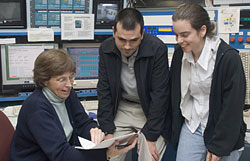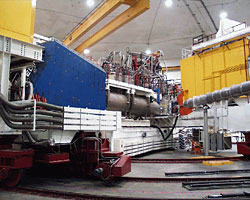
2007 News Release
Exploring the Universal Glue
January 9, 2007
In
Jefferson Lab's Hall C, an international collaboration of nuclear
physicists, the Fpi collaboration, is studying how the strong force
combines nature's fundamental building blocks into the lightest
particle built of quarks: the pion.

Like
protons and neutrons, pions are built of quarks - one constituent quark
and one anti-quark, to be exact. Pions also contain the quark-gluon
sea: a strong-force driven bevy of quarks and gluons constantly
blinking into and out of existence.
Probing the Strong Force
The strong force is one of the four basic forces of nature, along with
gravity, electromagnetism, and the less-familiar weak force. Inside the
nucleus of the atom, the strong force binds the smallest particles of
matter, quarks, together into protons and neutrons. In addition to
protons and neutrons, it also binds together other, simpler particles,
such as pions.
Like
protons and neutrons, pions are built of quarks - two quarks (one quark
and one anti-quark), to be exact. The quarks are bound together by the
strong force. The field generated by the presence of the strong force
also gives rise to additional, short-lived particles inside the pion: a
bevy of quarks and gluons that constantly blink into and out of
existence.
This group of extra particles generated by
the strong force is called the quark-gluon sea. By measuring the
quark-gluon sea, scientists can study the strong force at its most
basic level.
The
effects of the four forces of nature are visible all around us. The
strong force binds the smallest particles of matter together. Gravity
keeps the moon in orbit around the Earth and Earth in orbit around the
sun. We use the force of Electromagnetism to beam out radio and
television broadcasts and provide a power source to levitate and drive
new modes of mass transit.. Finally, the weak force enables the sun to
shine and explains some forms of radioactivity.
"The pion
is the simplest system made of quarks by the strong force," explains
Tanja Horn, a Hall C postdoc who, as a University of Maryland graduate
student, joined an international collaboration of more than 50
scientists to carry out a recent Jefferson Lab experiment to measure
pions. Horn says this relatively uncomplicated nature of the pion, as
compared to other quark-based particles such as protons, makes it an
excellent tool for probing the strong force.
Resolving the Pion with CEBAF
To accomplish this, physicists need three pictures of the pion. The
first is a snapshot of the pion from afar, revealing its overall
structure. The second is a very detailed look at the core of the pion,
where its resident quarks can be seen most clearly. The third is at a
resolution between these two extremes -- where the pion's two permanent
quarks may just be discerned amongst the bustling quark-gluon sea.

Betsy Beise, Dave Gaskell and Tanja Horn review pion data in the Hall C
Control Room. More than 50 nuclear physicists from around the world
came together to run the experiment.
These
snapshots are the goal of an international collaboration of scientists,
led by groups from Canada and the Netherlands, called the Fpi
Collaboration. The pion's form factor (Fpi) provides information on the
distribution of charge (from the two quarks and sea quarks) inside the
pion. Each quark contributes to this charge, whether it's one of the
resident quarks or a transitory quark appearing in the quark-gluon sea.
Previous research by the Fpi Collaboration in 2001 has
already provided snapshots of the pion from afar, rife with particles
from the quark-gluon sea. The Fpi Collaboration's goal in the recent
experiment was to access the third picture, where the two permanent
quarks may be seen amongst the quark-gluon sea particles.
Measuring Pions
The experiment was carried out in Jefferson Lab's Hall C in 2003. In
the experiment, energetic electrons were sent into a hydrogen target.
Physicists studied those instances in which an electron knocks a pion
out of the cloud of pions surrounding the nucleus. Pions were measured
in Hall C's high momentum spectrometer (HMS), and the scattered
electrons were measured in the short orbit spectrometer (SOS).
The new result was recently published in the November 10 issue of the journal Physical Review Letters.

Experimental Hall C
It shows that the resolution currently accessible with Jefferson Lab's CEBAF
accelerator is still far from the region where the pion appears as a simple
two-quark particle.
"We
don't see just the simple picture of the pion composed of two quarks.
There are the contributions from the sea quarks and gluons interacting,
which we call soft contributions," Horn says. These new
high-precision data are providing a stringent test for theoretical
models of pion structure that attempt to incorporate these important
soft quark-gluon sea contributions.
Plans are now being made for further experiments with the higher-energy electron beam proposed for the 12 GeV Upgrade at Jefferson Lab.
"With the 12 GeV upgrade, we can go to a higher resolving power," she
explains. The upgrade can extend the Fpi measurement, by doubling the
resolution accessible with Jefferson Lab's CEBAF accelerator.
More Information:
 University of Regina News Release featuring experiment co-spokesman Garth Huber
University of Regina News Release featuring experiment co-spokesman Garth Huber
Thomas Jefferson National Accelerator Facility’s (Jefferson Lab’s)
basic mission is to provide forefront scientific facilities,
opportunities and leadership essential for discovering the fundamental
structure of nuclear matter; to partner in industry to apply its
advanced technology; and to serve the nation and its communities
through education and public outreach. Jefferson Lab, located at 12000
Jefferson Avenue, is a Department of Energy Office of Science research facility managed by the Jefferson Science Associates, LLC.




